

Material tactility, its possibilities, limitations, and transformation form the core of Kelly Akashi's practice. Working in a variety of media, Akashi investigates the capacity and boundaries of these elements and their ability to construct and challenge conventional concepts of form.
In Cultivator (Cored), the title refers to ‘core sampling’ of the earth and the elements and materials that have come out of the earth’s layers. Metaphorically, elements have been excavated and presented on a turned walnut pedestal, dually representing cored earth, layers of sediment, and the artist's heartbeat which forms the undulations of the pedestal through an EKG she had taken.
Stone is shown in three forms in this work: a larger-than-life marble hand-carved via photogrammetry (3D scan), on the middle level in the form of a small travertine pedestal for two bronze cast fingers, and the third representation of stone is plaster, a form of processed stone. Despite the hard, solidified nature of the stone, growth continues to bloom through the core up to the networked sphere, indicating a future that is open to new potential.
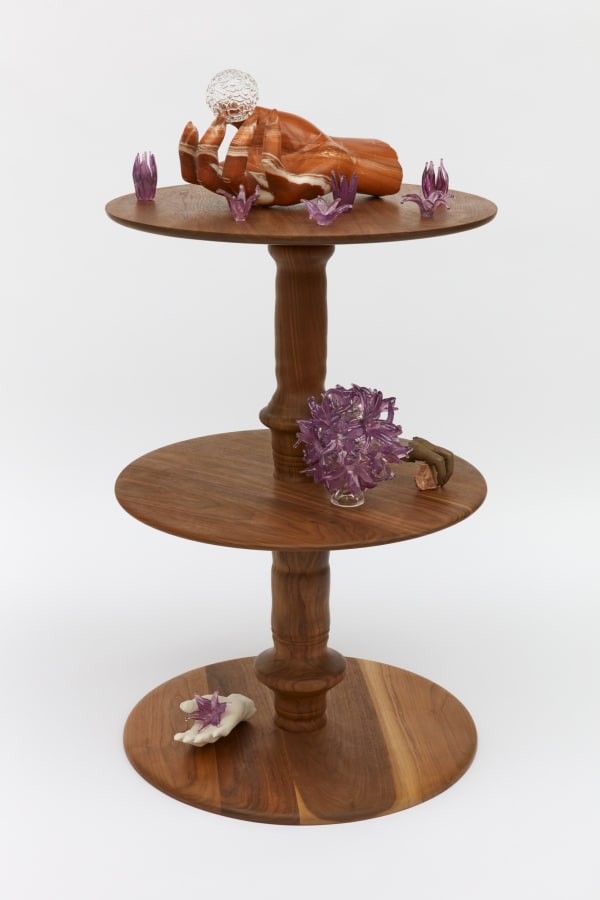
Kelly AKASHI
Cultivator (Cored)
2021
Hand-blown glass, comb red marble, bronze, flame-worked borosilicate, plaster, walnut pedestal
8 x 8 x 13 inches; 20.3 x 20.3 x 33 cm (marble hand)
42 x 23 1/2 x 23 1/2 inches; 106.7 x 59.7 x 59.7 cm (overall)
35 1/2 x 23 1/2 x 23 1/2 inches; 90.2 x 59.7 x 59.7 cm (pedestal)


Martin Boyce’s sculptures poetically investigate the intersections between art, architecture, design, and nature. Since the beginning of his career, he has incorporated a palette of shapes and forms that frequently recall familiar structures from the built environment – a phone booth, a chain-linked fence, a ventilation grill, to name a few – yet presents them in a way that is entirely new. In Hollows and Willow, a biomorphic structure resembling a tribal mask stands atop a weathered jesmonite plinth while a mobile made of industrial stainless steel chain hangs from the side recalling the form of a weeping willow.

Martin BOYCE
Hollows and Willow
2021
Painted and oiled plywood, lacquered steel, steel chain, clear lacquer, weathered jesmonite
59 x 18 1/2 x 15 inches; 150 x 47 x 38 cm (overall)
35 1/2 x 8 5/8 x 8 7/8 inches; 90 x 22 x 22.5 cm (plinth)
8 1/4 x 8 1/4 x 12 1/4 inches 31 x 21 x 22 cm (mask)
20 x 6 3/8 x 6 3/8 inches; 51 x 16 x 16 cm (mask stand)
Mobile: varies


Since the early 1990s, Sandra Cinto has developed a rich vocabulary of symbols and lines to create lyrical landscapes and narratives that hover between fantasy and reality. Using drawing as her point of departure, the artist renders intricate and mesmerizing seascapes, rainstorms, and celestial skies that frequently engage with the surrounding architecture to create seemingly weightless, immersive environments. Evoking stories of human hardship and redemption, Cinto's fantastical imagery serves as a metaphor for the human odyssey, while also pushing the limits and possibilities of drawing.
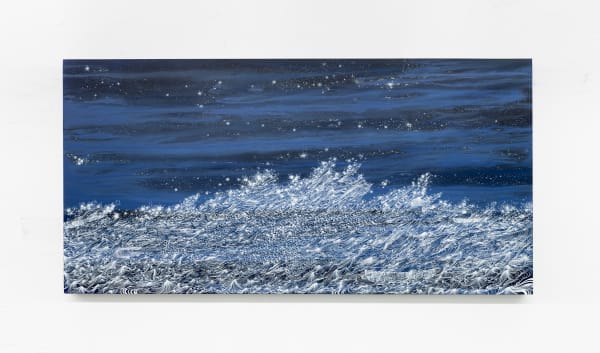
Sandra CINTO
A place to see stars
2021
Acrylic and permanent pen on canvas
39 3/8 x 78 3/4 inches; 100 x 200cm


The composition of circles and ellipses in this work is based on lens flare – rings and circles of light that appear in a camera’s lens when it is pointed towards the sun or another bright light source. Differently shaped panes of glass in a range of colours work together to produce the appearance of a group of overlapping transparent forms.
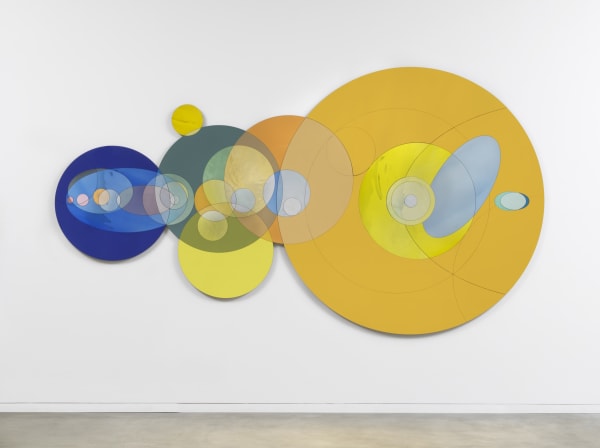
Olafur ELIASSON
The hesitant oracle flare
2021
Laminated colour glass mirrors (shades of blue, orange, green, yellow), silvered coloured glass (shades of purple, pink, blue, yellow, orange, green), composite board
78 3/4 x 143 7/8 x 1 1/8 inches; 200 x 365.4 x 3.5 cm

These two dimensional sculptural piece consists of colored glass panes from which elliptical shapes have been removed. Supported by a piece of horizontally installed driftwood, the glass panes lean upon each other, as their ellipses overlap, creating a variety of color saturation, shades, and tones.
The necessary imperfection of the finite balance is an extension of Olafur’s interest in the pigments and visual effects created by the superimposition of colored, transparent layers. The visitor oscillates between viewing the piece head-on— gaining the complete color spectrum of the combined panes—and from the side, discovering the depth and construction of the layers. In this oscillation, the focus fades from the colors to the objects that produce them, and back to the colors again.

Olafur ELIASSON
The necessary imperfection of the finite balance
2021
Coloured glass (yellow, purple, blue), silver, driftwood
42 3/4 x 59 1/2 x 5 1/8 inches; 108.5 x 151 x 13 cm


Remarkable in execution and detail, Composition with Two Ropes is produced through an intimate logic that has now become signature to Manders' practice. Rendered entirely in cast bronze, the work appears to be soft clay mid-way through the process of becoming a sculpture. In casting the sculpture in bronze, the artist freezes a very specific moment in time, highlighting the fragility of every moment that passes. The manipulation of material generates a sense of puzzlement and awe, masterfully creating a sense of timelessness— while the sculpture seems to be just made, it is at the same time enigmatically atemporal.

Mark MANDERS
Composition with Two Ropes
2019–2021
Painted bronze
16 1/2 x 21 x 13 5/8 inches; 42 x 53.6 x 34.6 cm
Edition of 3; 1 AP


Since the mid-1990s Ernesto Neto has produced an influential body of work that explores constructions of social space and the natural world by inviting physical interaction and sensory experience. Drawing from Biomorphism and minimalist sculpture, along with Neo-concretism and other Brazilian vanguard movements of the 1960s & ‘70s, the artist both references and incorporates organic shapes and materials engaging all five senses and producing a new type of sensory perception that renegotiates boundaries between artwork and viewer, the organic and manmade, the natural, spiritual and social worlds.
This recent work demonstrates Neto’s use of crochet as a formal and symbolic element. The act of knitting transforms small-scale artisanal craft into this large-scale sculpture. The slow, collective activity is precisely planned yet organic and on the verge of ritualistic, yet another powerful expression of Neto’s artistic inquiry. Dynamic color patterns are conjured by the craft of hand-dying each thread and mixing the colors.
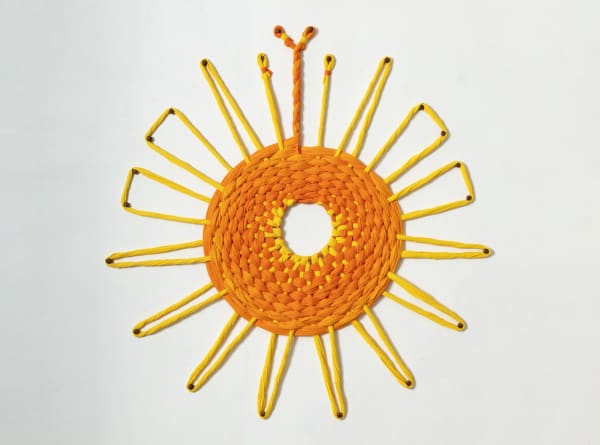
Ernesto NETO
Sun is God
2021
Cotton voile fabric and wooden knobs
101 1/8 x 98 1/2 x 1 3/4 inches; 257 x 250 x 3.5 cm


The title of the tapestry, inspired by poet Hilda Hilst’s Poemas Malditos, Gozosos e Devotos (1984), precisely reflects the current sociopolitical context in Neuenschwander’s native Brazil, but could easily apply to most post-colonial cultures around the world: a tropical setting damned throughout history as a colony of external power; orgasmic, as the role of exotic fantasy is projected upon its people; and devoted, throughout history, to dubious organized religion and faith movements. This new series of large-scale tapestries are based on the aesthetic of 17th century Japanese erotic wood cuts and inspired by Cordel folk literature popular in the Brazilian Northeast region. Scenes of violence are depicted in vivid colors and soft curving forms. Human bodies and anthropomorphic creatures intertwine in a brutal tug and pull, where phalluses, vulvas, and other bodily features are wrestling in muddy puddles of blood.

Rivane NEUENSCHWANDER
Trópicos malditos, gozosos e devotos 15
(Tropics: Damned, Orgasmic and Devoted 15)
2020
Wool, acrylic fiber, cotton
66 7/8 x 89 3/4 inches; 170 x 228 cm


Analia Saban dissects and reconfigures traditional notions of painting, often using the medium of paint as the subject
itself. This body of work continues Saban's investigations into the relationship between paint, pigment and canvas. Starting with her research into the history of pigments and the composition of paint that she conducted during a residency at the Getty Conservation Institute in 2016, Saban has continued to change the relationship between paint and canvas. In this work, a thin layer of dried acrylic paint is woven through the linen, physically embedded into the fabric of the painting.

Analia Saban
Woven Projection as Weft, Cadmium Red Medium #2
2021
Woven acrylic paint and linen thread on panel
70 1/4 x 68 1/2 x 2 1/4 inches; 178.4 x 174 x 5.7 cm


Informed by the worlds of art, architecture, natural sciences and engineering, Tomas Saraceno’s floating sculptures, community projects and interactive installations propose new, sustainable ways of inhabiting and sensing the environment. For more than two decades he has explored the possibility of a future airborne existence as part of his ongoing Air-Port-City / Cloud City project – a utopia of flying metropolises made up of habitable, cell-like platforms that migrate and recombine as freely as clouds themselves. Building on the progressive proposals and theories put forth by R. Buckminster Fuller, Gyula Kosice, Yona Friedman and other visionary architects before him, Saraceno develops engaging proposals and models that invite viewers to conceptualize innovative ways of living and interacting with one another, and with their surroundings at large.
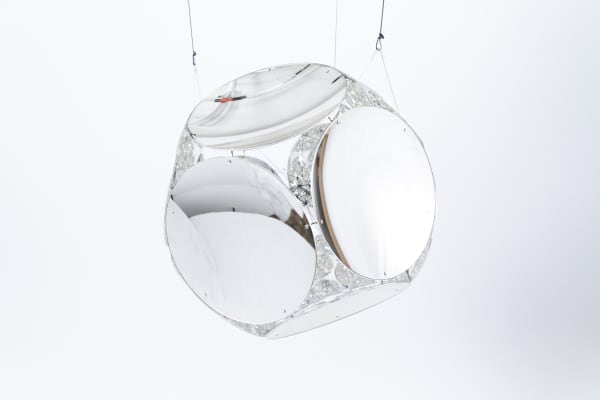
Tomás SARACENO
Echoes of an inversion
2021
Glass, metal, polyester rope, monofilament
60 cm diameter

Among the leading German artists of his generation, Thomas Scheibitz has developed his own conceptual language that bridges the realms of figuration and abstraction, at times dissolving them entirely. Drawing from classical painting and architecture, the contemporary urban landscape, and popular culture, Scheibitz deconstructs and recombines signs, images, shapes, and architectural fragments in ways that challenge traditional contexts and interpretations. While centrally concerned with principles of classification and systems of order, the artist’s paintings, sculptures and works on paper resist traditional categorization.
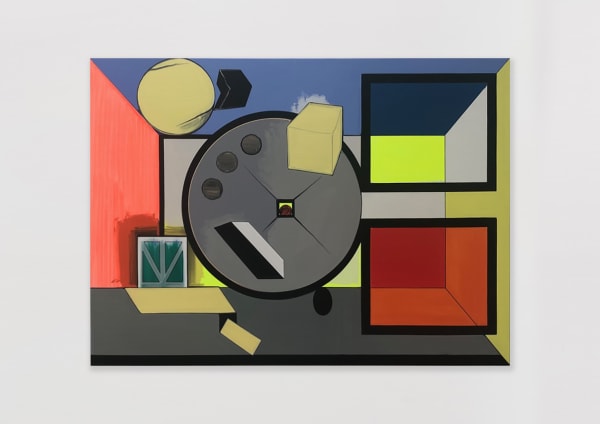
Thomas SCHEIBITZ
Zweite Maschine
2021
Oil, vinyl and pigment marker on canvas
63 x 86 5/8 inches; 160 x 220 cm

Haim Steinbach’s wall text installations investigate the boundaries of language, of feeling versus structure, and of perception, while challenging the audience as to what is being discussed. For Steinbach, typography is a “mask” on top of language or, literally, a “typeface.” This installation proposes that reading is an act of seeing, and that graphic codes, which proliferate our current media culture, accustom us to word and image arriving in the same package. Just as his found-object wall sculptures remind viewers that display is an ideological enterprise, his wall paintings and appliqués of found vernacular text serve also to play with established codes of interpreting what is seen.

Haim STEINBACH
lighten up
2008
Found text; matte black vinyl
Dimensions variable
Edition of 2

Gillian Wearing continues her exploration of identity, fiction and reality in her new series of works on paper. Conceived over the course of the COVID-19 pandemic, her new watercolor portraits have been created in this time of self-reflection motivated by isolation.
“I was going to begin painting my portrait this year, before COVID-19 took grip of the world and the nation. What surprised me was how the lockdown allowed me to focus in an intense way on a medium I hadn’t used for 33 years. Having represented myself in photography both as myself and as others, I wanted to see how paint and even the manner of painting could change my appearance. These new portraits provide a record of my time spent in lockdown and are an exploration of my image depicted in isolated concentration.” — Gillian Wearing
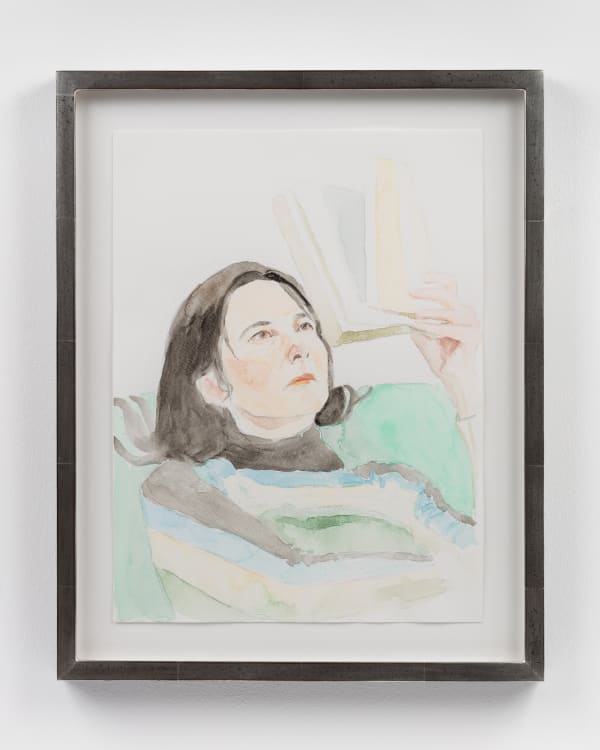
Gillian WEARING
Me reading Marguerite Duras
2021
Framed watercolor on paper
15 1/2 x 12 1/2 x 1 inches; 39.5 x 31.5 x 2.6 cm (framed)